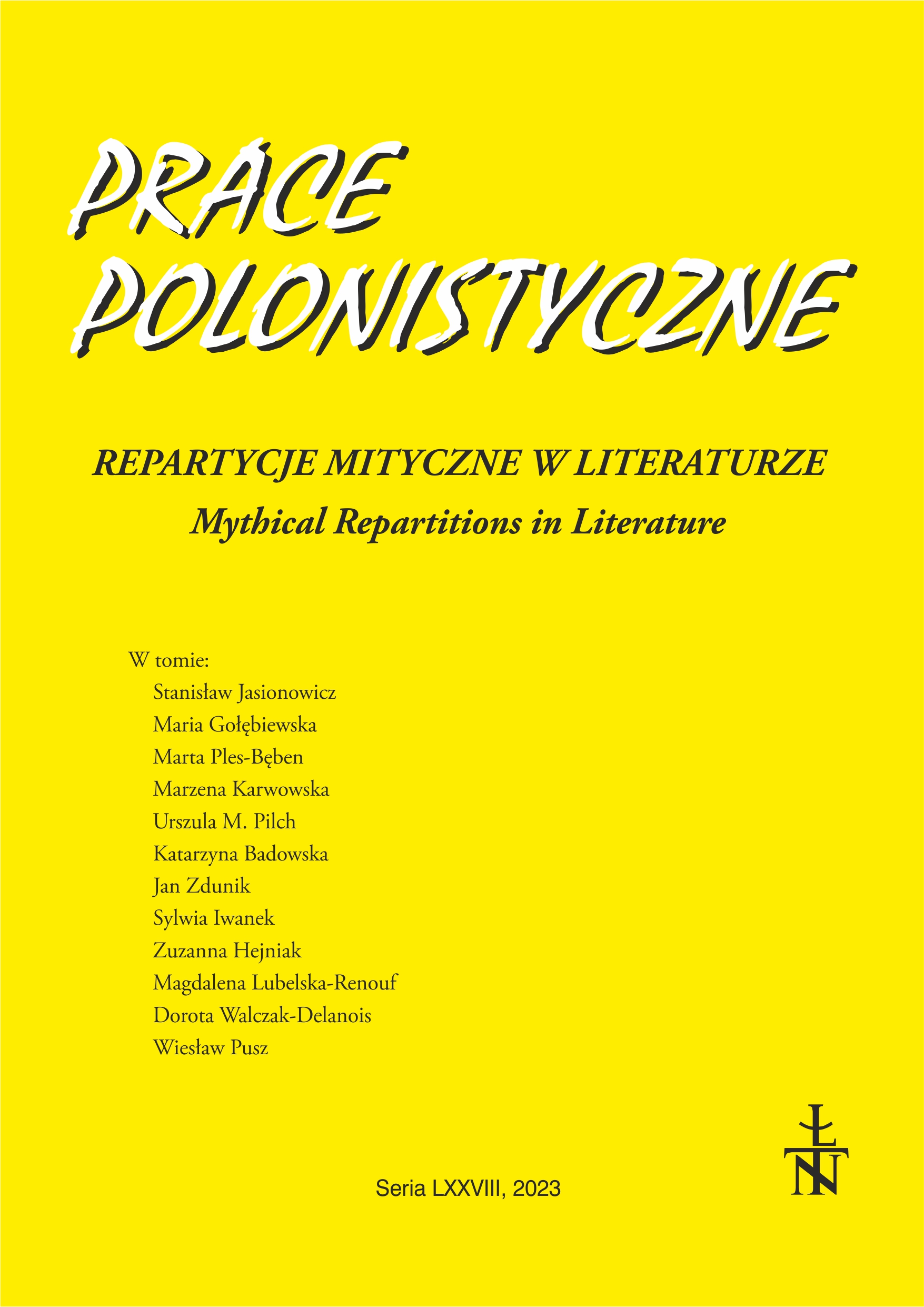Czesław Miłosz’s and Gilbert Durand's structures of the imaginary
DOI:
https://doi.org/10.26485/PP/2023/78/10Keywords:
the anthropological structures of the imaginary; imagination; image; myth; symbolAbstract
Gilbert Durand, the author of the classic The Anthropological Structures of the Imaginary, initiated a new area of research in the humanities, first in France and then worldwide. He proposed a morphological classification of broadly conceived structures of the imaginary, which includes symbols, images, and myths that are specific to a given author or culture. Drawing on various disciplines, Durand’s work can be seen as a vast undertaking aimed at rehabilitating the imaginary. He sees the imaginary is an art of human intellectual life and an essential aspect of human nature. Dreams, symbols, and images together constitute a kind of “transcendental fantastic”, without which a human being cannot experience wholeness or completeness. The article argues that the works of Czesław Miłosz, in which images form veritable magnetic fields gravitating around a number of central poetic symbols, can be read as a practical implementation of Durand’s theories.
Artykuł Magdaleny Lubelskiej-Renouf Czesław Miłosz’s and Gilbert Durand’s Structures of the Imaginary w języku polskim dostępny w: „Prace Polonistyczne” 2019, seria LXXIV, s. 29–51 (Magdalena Lubelska-Renouf, Struktury wyobraźni Czesława Miłosza i Gilberta Duranda).
References
Bachelard Gaston. 1971. The Poetics of Reverie: Childhood, Language, and the Cosmos. Trans. Daniel Russell. Boston: Beacon.
Bachelard Gaston. 1983. Water and Dreams: An Essay on the Imagination of Matter. Trans. Edith R. Farrell. Dallas: The Bachelard Foundation, The Pegasus Foundation, The Dallas Institute of Humanities and Culture.
Bergson Henri. 1974. The Two Sources of Morality and Religion. Trans. R. Ashley Audra, Cloudesley Brereton, W. Horsfall Carter. Westport, CT: Greenwood Press.
Bill Stanley. 2021. Czesław Miłosz’s Faith in the Flesh: Body, Belief, and Human Identity. Oxford: Oxford University Press.
Bulgakov Sergius. 2012. Unfading Light: Contemplations and Speculations. Trans. Thomas Allan Smith. Grand Rapids: William B. Eerdmans.
Cassirer Ernst. 1953. Language and Myth. Trans. Susanne K. Langer. New York: Dover.
Cassirer Ernst. 2021. The Philosophy of Symbolic Forms. Vol. 3. Phenomenology of Cognition. Trans. Steve G. Lofts. Abingdon: Routledge.
Corbin Henry. 1983. L’homme et son ange. Paris: Fayard.
Durand Gilbert. 1964. L’imagination symbolique. Paris: PUF.
Durand Gilbert. 1999. The Anthropological Structures of the Imaginary. Trans. Margaret Sankey, Judith Hatten. Brisbane: Boombana.
Frye Northrop. 1982. The Great Code: The Bible and Literature. New York: Harcourt Brace Jovanovich.
Guénon René. 1962. Symboles de la science sacrée. Paris: Gallimard.
Heuckelom Kris Van. 2004. Patrzeć w promień od ziemi odbity: Wizualność w poezji Czesława Miłosza. Warszawa: Instytut Badań Literackich PAN.
Kołakowski Leszek. 1982. Religion, If There is No God…: On God, the Devil, Sin, and Other Worries of the So-called Philosophy of Religion. Oxford: Oxford University Press.
Man and His Symbols. 1988. Ed. Carl Gustav Jung. New York: Anchor.
Miłosz Czesław. 1980. Nobel Lecture [online]. Access: https://www.nobelprize.org/prizes/literature/1980/milosz/lecture/ [25.11.2022].
Miłosz Czesław. 1982. Visions from San Francisco Bay. Trans. Richard Lourie. New York: Farrar, Straus, Giroux.
Miłosz Czesław. 1984. The Land of Ulro. New York: Farrar, Straus, Giroux.
Miłosz Czesław. 1990. A Notebook: Bon by Lake Leman. In: Aleksander Fiut. The Eternal Moment: The Poetry of Czesław Miłosz. Oakland: University of California Press. P. vii.
Miłosz Czesław. 1996. Poezje wybrane. Selected Poems. Trans. David Brooks et al. Kraków: Wydawnictwo Literackie.
Miłosz Czesław. 2003a. Eyes. Trans. Czesław Miłosz, Carol Miłosz, Renata Gorczyńska. In: Risking Everything: 110 Poems of Love and Revelation. Ed. Roger Housden. New York: Harmony. P. 126.
Miłosz Czesław. 2003b. New and Collected Poems, 1931–2001. New York: Ecco.
Miłosz Czesław. 2005. Second Space: New Poems. Trans. Czesław Miłosz, Robert Haas. New York: Ecco.
Miłosz Czesław. 2006. Selected and Last Poems. London: Penguin.
Miłosz Czesław. 2011a. A Threat to Nature. Trans. Adam A. Zych, Andrzej Diniejko. In: The Auschwitz Poems. Ed. Adam A. Zych. Oświęcim: Auschwitz-Birkenau State Museum. P. 289.
Miłosz Czesław. 2011b. Wiersze wszystkie. Kraków: Znak.
Pleşu Andrei. 2003. Despere îngeri. Bucureşti: Humanitas.
Renouf Magdalena. 2019. Blanc, lux et lumen dans la poésie de Czesław Miłosz. “Acta Universitas Lodziensis. Folia Litteraria Polonica”, no 55. Pp. 409–425.
Ricoeur Paul. 1970. Freud and Philosophy: An Essay on Interpretation. Trans. Denis Savage. New Haven: Yale University Press.
Sartre Jean-Paul. 2004. The Imaginary: A Phenomenological Psychology of the Imagination. Trans. Jonathan Webber. London: Routledge.
Downloads
Published
How to Cite
Issue
Section
License
Copyright (c) 2023 Łódzkie Towarzystwo Naukowe

This work is licensed under a Creative Commons Attribution-NonCommercial-NoDerivatives 4.0 International License.



